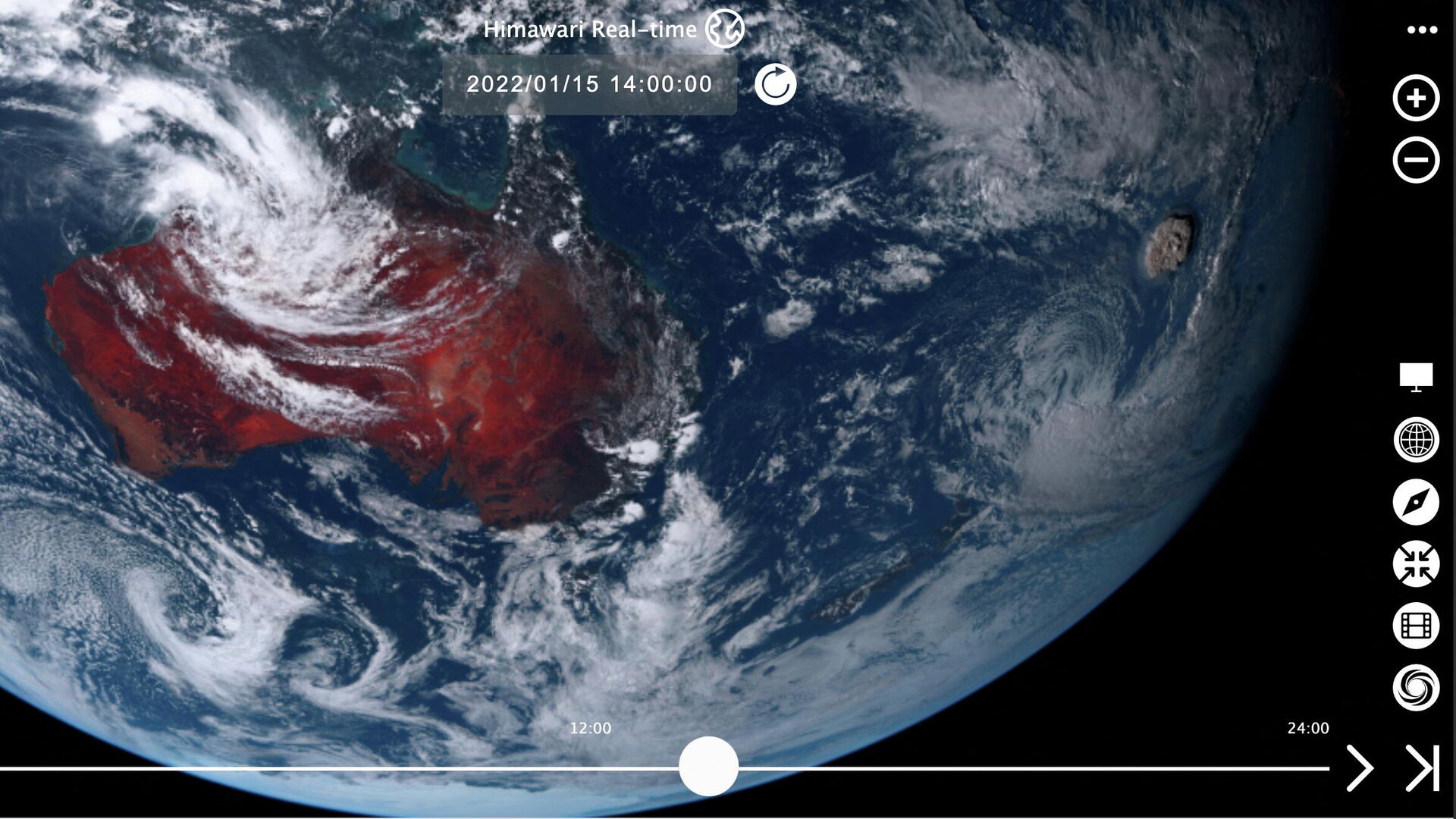https://sputnikglobe.com/20220117/tonga-underwater-volcano-eruption-may-cool-down-southern-hemisphere-scinetists-say-1092320651.html
Tonga Underwater Volcano Eruption May Cool Down Southern Hemisphere, Scientists Say
Tonga Underwater Volcano Eruption May Cool Down Southern Hemisphere, Scientists Say
Sputnik International
Experts say the eruption of the Hunga-Tonga Hunga-Ha'apai volcano on Saturday was one of the most violent in the Pacific region in decades. The explosion was... 17.01.2022, Sputnik International
2022-01-17T15:39+0000
2022-01-17T15:39+0000
2022-10-19T18:49+0000
new zealand
climate
volcano eruption
japan
australia
tonga
pacific
volcano
asia
https://cdn1.img.sputnikglobe.com/img/07e6/01/11/1092321959_446:0:2796:1322_1920x0_80_0_0_2274e699bf628dca36be3a9cb160f265.jpg
The underwater eruption of the Hunga-Tonga Hunga-Ha'apai volcano may bring down the mean temperature by 0.5 degrees Celsius in the Southern Hemisphere, predict climate scientists.Professor Jim Salinger, who co-authored a study on six significant eruptions over the last century, said Hunga-Tonga's eruption has pumped 0.4 teragrams of sulphur dioxide (SO2) into the stratosphere – the second layer of the atmosphere, which ranges between 10 km to 50 km from earth's surface. This sulphur dioxide will divert some of the sun's radiation away, lowering the temperature of the Earth's surface.Zeke Hausfather, a climate scientist at the Breakthrough Institute, said that post-eruption SO2 measurements show that it is probably not enough to affect global temperatures significantly. "That being said, more measurements will be taken, and more eruptions are possible," he added.The satellite imagery shows that Sulphur Dioxide plume has reached Australia on Monday, covering Queensland, and reaching the border of the Northern Territory.Most research suggests that the eruption's impact on the climate would likely be seen in the next few months, given it will take time for these tiny particles to disperse over the Southern Hemisphere.Meanwhile, Fiji's government said that the Sulphur Dioxide concentration in the atmosphere increased overnight, resulting in acidic rainfall in the region.James Renwick, Head of School of Geography, Environment, and Earth Sciences at Victoria University of Wellington, observed that Tonga's eruption would have a significant impact locally, "but it's not likely to affect the global climate."Researchers have agreed that Tonga's eruption was not as large as Mount Pinatubo in the Philippines, which injected 20-million-tonnes SO2 into the stratosphere in June 1991. Scientists found that the Earth's mean temperature comes down by 0.3 degrees Celsius.Several experts analysed the satellite data and observed that total SO2 emissions from Tonga are roughly 2 percent of Pinatubo.
new zealand
japan
australia
tonga
pacific
Sputnik International
feedback@sputniknews.com
+74956456601
MIA „Rossiya Segodnya“
2022
Rishikesh Kumar
https://cdn1.img.sputnikglobe.com/img/07e4/08/04/1080055820_0:0:388:389_100x100_80_0_0_40018ee210946d65d49ffba4f4c008e1.jpg
Rishikesh Kumar
https://cdn1.img.sputnikglobe.com/img/07e4/08/04/1080055820_0:0:388:389_100x100_80_0_0_40018ee210946d65d49ffba4f4c008e1.jpg
News
en_EN
Sputnik International
feedback@sputniknews.com
+74956456601
MIA „Rossiya Segodnya“
Sputnik International
feedback@sputniknews.com
+74956456601
MIA „Rossiya Segodnya“
Rishikesh Kumar
https://cdn1.img.sputnikglobe.com/img/07e4/08/04/1080055820_0:0:388:389_100x100_80_0_0_40018ee210946d65d49ffba4f4c008e1.jpg
new zealand, climate, volcano eruption, japan, australia, tonga, pacific, volcano
new zealand, climate, volcano eruption, japan, australia, tonga, pacific, volcano
Tonga Underwater Volcano Eruption May Cool Down Southern Hemisphere, Scientists Say
15:39 GMT 17.01.2022 (Updated: 18:49 GMT 19.10.2022) Experts say the eruption of the Hunga-Tonga Hunga-Ha'apai volcano on Saturday was one of the most violent in the Pacific region in decades. The explosion was so loud it could be heard hundreds of kilometres away. It also triggered tsunami warnings in countries with Pacific Ocean coastline
The underwater eruption of the Hunga-Tonga Hunga-Ha'apai volcano may bring down the mean temperature by 0.5 degrees Celsius in the Southern Hemisphere, predict climate scientists.
Professor Jim Salinger, who co-authored a study on six significant eruptions over the last century, said Hunga-Tonga's eruption has pumped 0.4 teragrams of sulphur dioxide (SO2) into the stratosphere – the second layer of the atmosphere, which ranges between 10 km to 50 km from earth's surface.
This sulphur dioxide will divert some of the sun's radiation away, lowering the temperature of the Earth's surface.
"What we'll probably see in the next two months is rather magnificent sunsets as the sulfuric acid mist slowly descends from the stratosphere – but I'd also expect cooling in our region to amount to a few tenths of a degree, maximum," Salinger said on Monday.
Zeke Hausfather, a climate scientist at the Breakthrough Institute, said that post-eruption SO2 measurements show that it is probably not enough to affect global temperatures significantly. "That being said, more measurements will be taken, and more eruptions are possible," he added.
The satellite imagery shows that Sulphur Dioxide plume has reached Australia on Monday, covering Queensland, and reaching the border of the Northern Territory.
Most research suggests that the eruption's impact on the climate would likely be seen in the next few months, given it will take time for these tiny particles to disperse over the Southern Hemisphere.
Meanwhile, Fiji's government said that the Sulphur Dioxide concentration in the atmosphere increased overnight, resulting in acidic rainfall in the region.
James Renwick, Head of School of Geography, Environment, and Earth Sciences at Victoria University of Wellington, observed that
Tonga's eruption would have a significant impact locally, "but it's not likely to affect the global climate."
"Sure, it's cutting a bit of sunlight reaching that particular part of the tropics, and what's in the aerosol cloud will spread out in the stratosphere – but that's not going to lead to significantly cooler temperatures," he said.
Researchers have agreed that Tonga's eruption was not as large as
Mount Pinatubo in the Philippines, which injected 20-million-tonnes SO2 into the stratosphere in June 1991. Scientists found that the Earth's mean temperature comes down by 0.3 degrees Celsius.
Several experts analysed the satellite data and observed that total SO2 emissions from Tonga are roughly 2 percent of Pinatubo.



